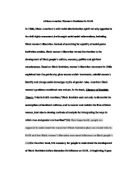African-America Women’s Feminism in BAM
In 1960s, Black American’s anti-racial discrimination spirit not only appealed to the civil rights movement, but brought serial social reformations, including Black women’s liberation. Instead of searching for equality of social power institution outside, Black women’s liberation turned its attention to the development of Black people’s culture, economy, politics and spiritual consciousness. Based on Black feminism, women’s liberation movement in 1960s explained how the patriarchy gives women unfair treatments; rebuild women’s identity and change social stereotype myths of gender roles. American Black women’s problems combined race and sex. In the book, Glossary of Feminist Theory, Valerie Smith mentions,“Black feminists seek not only to dismantle the assumptions of dominant cultures, and to recover and reclaim the lives of black women, bust also to develop methods of analysis for interpreting the ways in which race and gender are inscribed”(23) Most importantly, people are supposed to understand the reason how Black feminism plays an crucial roles in BAM and how Black women’s liberation movement influences on Black people’s world.
On the other hand, it is necessary for people to understand the development of Black Feminism before discussion its influence on BAM. At beginning, it goes without saying that their opposition to racism and sexism identifies Black feminism. In other words, when Black people devoted themselves to fighting their rights and castes, the issues of Black women’s freedom were seldom-caught attention by Black Community. In the article, “The Battlefield Called Life: Black Feminism Dreams,” Kelley notes women’s questions are often seen to be the minor object in American Left (136). “Third World-identified revolutionaries had much to say about class, culture, and internationalism, but little to say about women” (136). Similarly, the author whose name is Solomon in the article “Cultural-Oriented Feminism” also proves the point that the Black males regard Black females as less important roles in Black political positions. During the early 1960s, women seldom could control and lead most protest movements; however, some feminists in the civil rights and the New Left could learn lessons from males’ controlling world (83). Black females understood how they were oppressed by sexism. For example, “women in the civil rights movement found themselves systematically excluded from policy-making positions” (84). Moreover, women in the movements usually do “domestic chores” which apparently they were seen as second-class citizens and inferior roles (83). Owing to most Black women were treated in unfair way, then the radical consciousness appealed at that time. In other words, “ Women’s involvement in civil rights and the Left not only brought then to new level of awareness about the restrictions of sex, but also served as a training ground for many future radical feminists” (83). The term radicalism in BAM is to destroy and build anew without improving gradually, so the term radical also plays a significant role in Black women’s liberation. Since “Radical Humanism” means that Black feminism share the common experience and detestation of patriarchy (Kelley 137). Moreover, Mao’s theory on women also could correspond with radical feminism, because it opened new room for Black women to have equal to that of men (Kelley 97). In this way, “African-American women radicals rose to positions of prominence… contributed to developing a militant, class-conscious, Black feminist perspective” (97). In other word, the term radical means to be “a disturber of the peace” (Solomon 82). Peace is regarded as the normal standards by cultural society; Robert Zaller says that “[people] define radicals as those seeking fundamental change by striking at the very root of contemporary assumption…” (82). In conclusion, radicalism for women is also as much important as for men; “Going to the roots thesis of black and female radicals gave rise to a commitment that focused on long-standing external realities different from those concerning other historical protect movement challenging the American consensus” (Solomon 83).







